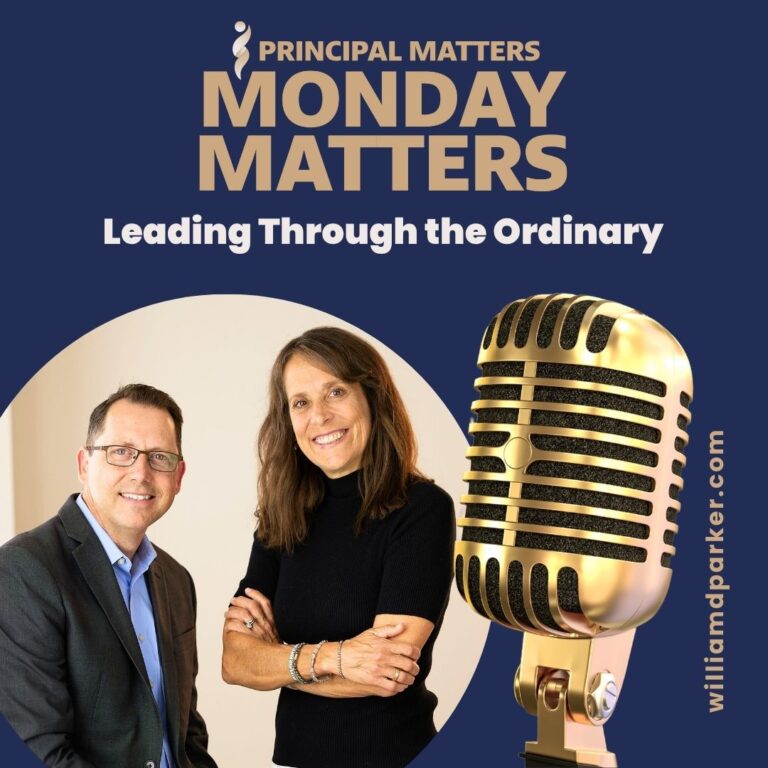Podcast: Play in new window | Download
When I was going to graduate school for my Master’s Degree in Education Leadership, I decided to conduct my own informal research.
Over a number of weeks, I talked to current and retired principals about what they considered to be the lessons they had learned from their years in school leadership.
I remember one man in particular who was a retired teacher and administrator who had moved into higher education. We stood in the hallway one night after one my classes, and I asked him the question:
“What do you consider the greatest lesson you learned from your years as a principal?”
He looked down for a moment, and then looked back up at me and said. “I think I had to learn that I wasn’t always right. In fact, looking back now, I think I’d be lucky if I made the right decision 25% of the time.”
I was shocked. How could someone who seemed so articulate, competent, and confident say such a thing?
He smiled and explained. “Before you become the principal, you think you have all the answers. But once you take the position, you begin to realize how many things you don’t know…and sometimes you will call it wrong.”
“The sooner you accept that fact,” he went on, “The easier it will be to not be too hard on yourself when you make mistakes.”
I still remember walking away from that conversation in a daze.
Looking back at the conversation now years later, I realize that some of my biggest fears centered on a fear of failure: disappointing others, making the wrong call, or being out-of-control of a situation. I wanted to be someone who inspired confidence in others, and the idea of making the wrong calls terrified me.
How Would You Handle This Situation?
I remember my first few weeks as an assistant principal when a teacher brought a student to me. She was upset because he had been playing around in her classroom, and he had thought it would be funny to make dozens of photo-copies of his face on a copier she kept there. This incident turned into a long meeting with his dad, the teacher, and me. We decided he would report for two weeks to her classroom each morning to help her organize materials, etc. as a way to give back for the nuisance and waste.
Although the outcome was positive, I would have handled it differently today:
1. This was a veteran teacher, and I might have encouraged her to first contact the parent herself.
2. Perhaps we would have talked about what appropriate consequences she could leverage, and she could have easily managed it without me organizing a meeting.
3. This would have saved time for the school and the parent, and the student would still have had a reasonable consequence.
4. I would laughed about it afterwards.
But I didn’t have those insights then. I didn’t know that teachers must be empowered to manage and resolve classroom incidents within their own control. I didn’t know how important it is to protect time by not allowing “urgent” moments to take hours away from other important priorities where my presence and input were more essential. I didn’t have the perspective of being a parent of teenagers myself yet. And I didn’t know how to enjoy the hilarious things kids do sometimes.
That is just a small example of the thousands of hourly and daily decisions I’ve helped manage since then. But my point is that hindsight allows us perspective on how we grow in decision-making.
The Wisdom of Hindsight
Making good decisions is an important role for each us. A 2008 Harvard Business research report, How Can Decision Making Be Improved? by Katherine L. Milkman, Dolly Chugh and Max H. Bazerman, explains how errors in decisions can be costly. And decision making is often based on both intuition and outside input.
Although we should constantly work on ways to improve our decision-making, when I look back over the years, I can see many other ways I would make different decisions if confronted with the some of the same situations today. And I have a shocking truth to share with you: You’re probably not a perfect decision-maker either.
So what would be my advice to someone who has taken on the task of decision-making knowing they may inevitably stumble at times or miss the mark?
First don’t be overwhelmed by the inevitable.
Second, there are ways you can still minimize errors and maximize outcomes.
I have talked about some of those in a previous post: Six Ways to Avoid Wrong Calls, but today I want to focus on six tips to keep in mind when you realize you still call it wrong at times:
6 Tips for Growing in Decision-Making
1. Even though you won’t always get it right, make the courageous choice.
A strong leader understands his or her policies and procedures while also understanding that policies don’t protect you from tough choices.
You are going to face situations in human behavior you’ve never considered before. Every year I’m confronted with something new: just as young people have endless ideas for ways for creativity and learning; likewise, they have endless on ways to surprise, offend, or break rules.
When you’ve had time to weigh the options, ask yourself, “What would a strong leader do in this situation?” When you’ve weighed the best options, make the courageous, not convenient choice. Others will respect you more when you do, and you will maintain self-respect as well.
2. Don’t be afraid to take smart risks or step out of your comfort zone.
Decision-making is not just about discipline. It also about goals, schedules, or problem solving. But sometimes it involves looking beyond the immediate to see where a group or organization needs to be going next.
It is easy to fall into routines in our work, so I believe you stay fresh in leadership when you are constantly looking for ways to improve, and that starts first with yourself.
So let me ask you this: When is the last time you tried something that pushed you outside of your comfort zone?
Maybe you could cover a lesson with students when a teacher is absent or be willing to sit in a dunk tank for your next fundraiser. Or it could be taking time to write or speak about a topic you’ve mastered.
Whatever it is, keep making decisions that require you to stay focused, present, and push you toward growth.
3. Surround yourself with others who provide wisdom and perspective.
No one should ever lead in isolation. The more people you can surround yourself with for guidance, the better. That’s one reason I try to meet every week with my admin team, teacher teams, or student council members.
How are you reaching out to the people who know best what is happening and who can provide realistic feedback? When it comes to tough decisions, stop, think, and ask others for feedback before taking action.
4. Take time to celebrate and enjoy small wins.
Don’t become so absorbed in “doing” that you forget “being”. In other words, look around at what is working well in your school. And then pause to celebrate.
Maybe you can send out social media alerts on awesome activities or lessons happening. Or maybe it means taking time to tell someone on your team a specific way you saw them model inspiration, enthusiasm, and good teaching. Leadership has a lot of moments managing conflicts, so don’t let that make you numb to the wonderful things happening throughout your school everyday. When you see the evidence or benefits of good-decision-making, celebrate the outcomes.
5. Even if the steps are small, keep moving forward.
If leadership was easy, everyone would be signing up for more responsibility. Whether you are a classroom leader, a coach, or in school admin, don’t forget that resistance comes with the territory.
In classroom settings, I’ve heard students say before, “If I can just get Mr. or Mrs. __________________ off topic, we can talk about nothing for the rest of the class period.” Teachers aren’t the only ones who can get sidetracked.
Even after making a big decision, ask yourself: What is it I really need to be focusing on now? Maybe that is being in classrooms or researching answers to another new challenge.
At the end of the day, ask yourself: Did I move the needle today? Am I making progress toward our main goals? What little step can I take right now if I haven’t?
6. Always do what is legal and ethical; if you’re not sure, ask!
Yes, we’re all susceptible to bad decisions, but I think it goes without saying that any decision should be grounded in policy, procedure, and what’s legal.
Seek good counsel if you’re stepping into an area that is controversial or open to varying interpretations. You will face many situations where the answers are already spelled out for you, especially when it comes to confidentiality and due process.
But sometimes the answers are not so clear; those are times when decisions should be shared with others who have experience or expertise in that area. Yes, be courageous. But being courageous does not mean being reckless or negligent.
Conclusion
Understanding your own leadership strengths and weaknesses is a never ending process. On the one hand, good decision-making requires you to constantly learn, share, collaborate, and seek input. On the other hand, the longer you practice these habits, the more aware you become of how much you still need to learn and how prone you are to sometimes missing the mark.
So save yourself some time, and accept the “shocking news” that you always have room to grow. When you do, you will be able to still live with yourself on the good days and the bad ones.
Remain courageous, take smart risks, rely on teamwork, celebrate small wins, move forward, and do what is ethical. When you you do, you’ll keep growing, and you’ll make the journey even better for those whom you’re serving and leading.
Now It’s Your Turn
When is the last time you’ve reflected on your decisions? Are you seeking input from others to see if you have any blind spots in decision-making or need another perspective? What’s one way you can “move the needle” today to keep moving toward your most important goals even in the midst of managing so many decisions?
Principal Matters Podcast
Check out audio versions of my posts at iTunes. Rate PMP at iTunes; when you do, it makes it more visible to others!
Sign-Up For Free Updates and Ebook
When you enter your email address here, you will automatically receive my newest posts and a free Ebook, 8 Hats: Essential Roles for School Leaders. Let’s keep learning together!
Principal Matters–The Book!
School leaders are very busy, so each of the twenty-four chapters is designed as a quick-read and followed with take-action questions for follow-up or reflection. If you want practical ideas on understanding your purpose, managing school teams, dealing with challenges, and leading with courage, action, motivation, and teamwork, go HERE to pick up a copy for you or your team.




